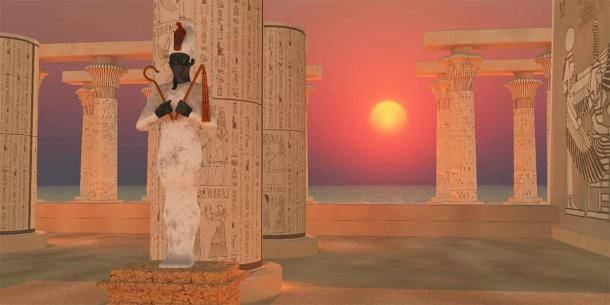In Egypt, the pharaoh, who was the living incarnation of Horus, the son of Isis and Osiris, would undergo at death a transformation from being the living Horus to being the dead and resurrected Osiris. Pharaoh was, by inheritance, the anointed king-god of his people: in essence he was the equivalent of the Greek Christos, a messiah.

Osiris God Statue – The Egyptian god of resurrection and the afterlife Osiris stands as a statue in a temple in the desert. ( Catmando/ Adobe Stock )
The word ‘pharaoh’ means literally ‘great house’. Throughout human history dynastic lineages have always been referred to as houses—the house of David is a case in point. This architectural term denotes the idea that the lineage descends from the gods—who reside in temples, and therefore, the origin of the line is divine. In the case of David and Solomon it was the tabernacle and then the Jerusalem temple. In the case of the pharaohs it can only mean the most revered monument in Egyptian history—and the most sacred place in its history: the Great Pyramid . The pyramid is Osiris; therefore the pharaoh, as Osiris’ son Horus, has to be referencing this extraordinary monument as the meaning of his title; and as the anointed Son of God, he is also the master of its liturgy and ritual.
During his sojourn in the King’s Chamber, John Reid discovered that the mysterious sarcophagus there shares the same resonant frequency as the heart of a newborn baby. This remarkable fact immediately points only in one direction.

Shafts Inside the Great pyramid. (hlxandr / Adobe Stock )
The Ovule In The Pyramid
Running in an outward direction from the interior of both the King’s and Queen’s Chambers in the Great Pyramid are four so-called ventilation shafts. There are two in each chamber. One of the shafts in the Great Pyramid was until very recently ovular in form. The two shafts do not run directly from the interior and outward; there is first a small entrance chamber at the end of which the shafts begin their ascent. When in the mid-1990s one of the shafts in the King’s Chamber was earmarked for a new ventilation fan, in an attempt to control the humidity and keep the interior temperature constant, not much attention was paid to the symbolic nature of its form: its shape was duly destroyed after only a rudimentary survey was made and the form is forever lost. However, the shape remains intriguing.
Like this Preview and want to read on? You can! JOIN US THERE ( with easy, instant access ) and see what you’re missing!! All Premium articles are available in full, with immediate access.
For the price of a cup of coffee, you get this and all the other great benefits at Ancient Origins Premium. And – each time you support AO Premium, you support independent thought and writing.
Based on an excerpt of David Elkington’s The Ancient Language of Sacred Sound published by Inner Traditions.
David Elkington is an independent academic and historian, specializing in Egyptology and Egypto-Palestinian links. He has lectured at Oxford and Cambridge Universities and appeared on many television programs, including Forbidden History. He lives in The Hague, Netherlands. He is the author of The Ancient Language of Sacred Sound
Top Image : Pyramid in the sand ( Givaga / Adobe Stock )
Related posts:
Views: 0
 RSS Feed
RSS Feed

















 May 27th, 2021
May 27th, 2021  Awake Goy
Awake Goy  Posted in
Posted in  Tags:
Tags: 
















